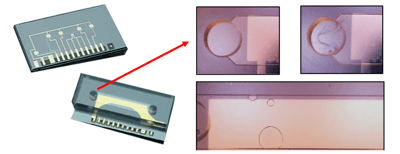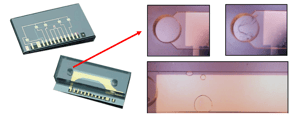Proteins exhibit a wide range of solubility based on many factors such as solvent composition, pH, and ionic strength. Protein solubility depends on both the specific protein and solvent used. Using a single, universal cleaning solvent (e.g. 1% Aquet), when running viscosity measurements on VROC® chips, may not be optimal depending on the properties of the protein sample. Choosing the correct primary solvent can extend the life and maintain the high performance of your VROC chips.
Some high-concentration protein solutions can leave thin residue films in the microfluidic channel of the VROC chip, which can lead to a decrease in measurement quality. The VROC® initium automated viscometer uses 1% Aquet as the primary solvent during automatic post-sample cleaning. This solvent is sufficient, in most cases, for water-soluble samples (e.g., bovine serum albumin (BSA) dissolved in phosphate buffered saline (PBS)). However, proteins with low solubility, such as Bovine Gamma Globulin (BGG), may be difficult to remove completely with 1% Aquet. Over time, protein accumulation in the microfluidic channel could decrease the accuracy and repeatability of your measurements.
In fall 2020, RheoSense released the new VROC® initium one plus! This leading automatic high throughput viscometer allows you to characterize your unique samples with viscosity fingerprinting! The VROC initium one plus cleaning protocols only use PBS as the primary cleaning solvent, as opposed to the initium which, as mentioned above, uses 1% Aquet as the primary solvent. This change was made because we discovered buffer cleaning works so well that when releasing the VROC initium one plus made the full switch to using buffer for the one plus (Buffer/1% Aquet/Acetone)! The only difference between the initium and initium one plus protocols are that we now use Acetone as the last solvent to speed up the drying process.
To improve cleaning performance, we have developed several cleaning methods for high concentration protein solutions, allowing users to choose the optimal primary cleaning solvent for their protein solutions. For example, cleaning BGG samples using PBS as the primary buffer can result in vastly improved measurement repeatability between samples. The buffer cleaning setup requires modifications of the solvent configuration and loading and cleaning protocols, so please contact us for more information.
If you suspect that your chip may already be suffering from protein buildup all hope is not lost! We have found that protein residue can be successfully removed by soaking 1% solution of Tergazyme™ Enzyme-Active Powdered Detergent (by Alconox™) in the flow channel at an elevated temperature (50°C). Tergazyme can also be automatically loaded and soaked in the initium through sample loading and measurement protocols we have developed. Want to learn more about about cleaning and maintaining your VROC® chips, or about our cleaning protocols? Contact Us!




